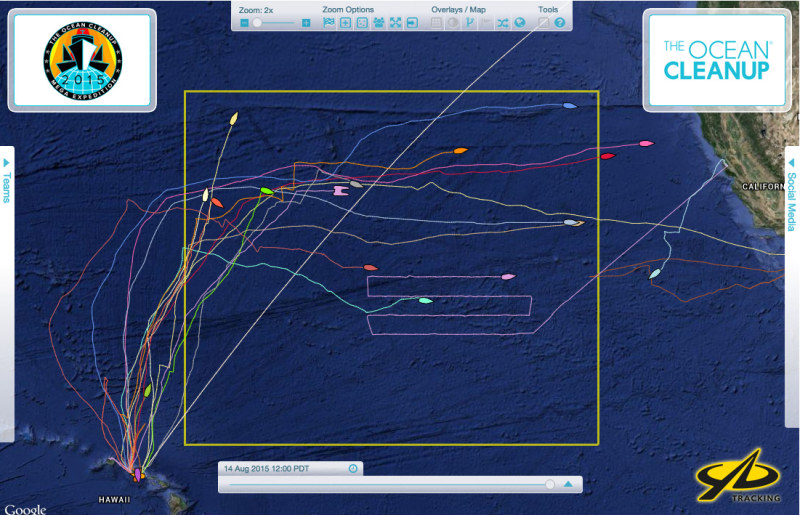
Trawling for a Cause
Racing to Hawaii in the Transpac or Pacific Cup is almost always an exhilarating and uplifting experience. But in recent years many racers have been sobered along the way by encounters with large patches of plastic garbage, and in some cases pieces of debris large enough to sink a good-sized sailboat.
Because the massive North Pacific Gyre (or Garbage Patch) lies beyond the territorial waters of any nation, it’s really no government’s job to clean it up. That’s one of the reasons that scientists and sailors have teamed up to support The Ocean Cleanup, an ambitious effort to clean up the North Pacific’s surface pollution using a revolutionary collection device — a prototype of which is now being tested in Japan.

©Latitude 38 Media, LLC
Before the Cleanup can begin, however, researchers need current data on where the greatest concentrations of floating junk lie. That’s why the tracks of two dozen Transpac boats appear to be traveling close to specific latitude lines as they return to the West Coast. As reported earlier, they are participating in an effort called The Mega Expedition, which involves collecting data via specially designed trawl devices, several times each day.
The whole Cleanup idea may seem wildly ambitious and unlikely to succeed, but in an era when the voices of naysayers often overwhelm those of optimists, it’s refreshing to see a group of ordinary people at least attempting to make a positive change to a problem that, to many, seems impossible to solve. So we applaud the participating boat owners and their crews for volunteering to collect this crucial data. No extensive debris mapping of the 1.4-million-square-mile Gyre has ever been done before.
In addition to the mothership, San Francisco-based, 171-ft research vessel Ocean Starr, participating boats are:
• Patches / TP52 / Eduardo Porter Ludwig
• Between The Sheets / Jeanneau Sun Fast 52 / Ross Pearlman
• Varuna / Rogers 46 / Chris Hemans
• Lucky Duck / Santa Cruz 52 / Dave MacEwen
• Boomerang / Bashford 41 / John Spataro
• Adrenalin / Santa Cruz 50 / Andy Bates
• Lucia e Luca / Jeanneau 53 / Richard Rogg
• Westward / Lapworth 50 / Sam Bell
• Pipe Dream / Davidson 50 / John Davis
• Wizard / Reichel Pugh 74 / David & Peter Askew
• Magnolia / 65 ft Schooner / Heather Elrix
• Dos Palabras / Formosa 41 / Paul Bischoff
• Stay Gold / Rawson 30 / Jason Frechette
• ExtremeH20 / Gunboat 66 / Pat Benz
• Carinthia / Lagoon 440 / Dietmar Petutschnig
• Laysan / 462 Sedan / John Douglas
• Sleeper / Jeanneau Sun Odyssey 44 / Ron Simonson
• Second Wind / Swan 651 / Dean Fargo
• Hokahey / Santa Cruz 52 / George Bailey
• Relentless / Santa Cruz 52 / Bill Durant
• Destroyer / TP52 / Eduardo Saenz Hirschfeld
• Timeshaver / J/125 / Viggo Torbensen
• Swiftsure / Nelson/Marek 68 / SailingSwiftsure
• Chim Chim / Gunboat 62 / John Gallagher
• Manu Iwa / CSK Catamaran / Dave Cunningham
